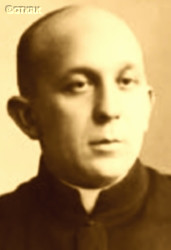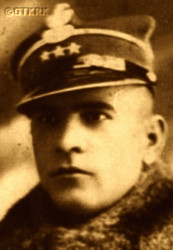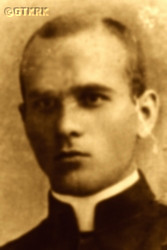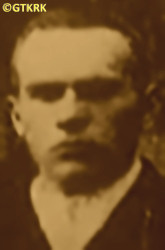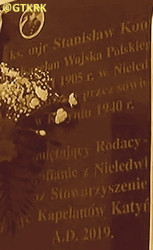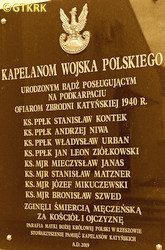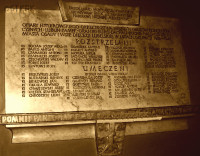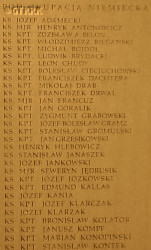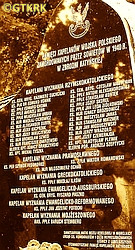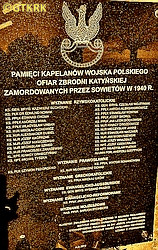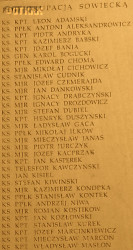Roman Catholic
St Sigismund parish
05-507 Słomczyn
85 Wiślana Str.
Konstancin deanery
Warsaw archdiocese, Poland
full list:
displayClick to display full list

searchClick to search full list by categories
wyświetlKliknij by wyświetlić pełną listę po polsku

szukajKliknij by przeszukać listę wg kategorii po polsku

Martyrology of the clergy — Poland
XX century (1914 – 1989)
personal data
surname
KONTEK
forename(s)
Stanislav (pl. Stanisław)
function
diocesan priest
creed
Latin (Roman Catholic) Church RCmore on
en.wikipedia.org
[access: 2014.09.21]
diocese / province
Lublin diocesemore on
pl.wikipedia.org
[access: 2013.05.19]
RC Military Ordinariate of Polandmore on
en.wikipedia.org
[access: 2014.12.20]
academic distinctions
History and Philosophy MA
honorary titles
War Order of Virtuti Militari — Silver (5th Class)more on
en.wikipedia.org
[access: 2019.10.13]
(11.11.1976, Londontoday: London Cou., England, United Kingdom
more on
en.wikipedia.org
[access: 2024.03.19], decree of Stanislav Ostrowski, President of the Republic of Poland in exile)
September Campaign Crossmore on
pl.wikipedia.org
[access: 2023.11.24]
(01.01.1986, Londontoday: London Cou., England, United Kingdom
more on
en.wikipedia.org
[access: 2024.03.19], decision of George Premyslav Morawicz, Minister of Military Affairs of the Polish Government in exile)
Silver „Cross of Merit”more on
en.wikipedia.org
[access: 2019.04.16]
(29.10.1938)
date and place
of death
11.04.1940

NKVD Katynholiday resort
form.: Kozye Gory forest
today: Smolensk reg., Smolensk oblast, Russia
more on
en.wikipedia.org
[access: 2020.09.24]
alt. dates and places
of death
12.04.1940, 13.04.1940
details of death
During World War I, an activist — as a scout — of the Polish Military Organization POW (a clandestine Polish organization in Russia active during World War I in 1914‐1918). In 10.1918, took part in the disarmament of German and Austrian soldiers in Chełm.
On 19.07.1919, as a 15‐year‐old volunteer (stating 1901 as his year of birth), enlisted in the Mounted Rifle Regiment and fought in the Polish–Russian War of 1919‐1921. Wounded during the Kiev expedition in 05.1920, taken prisoner, from which managed to escape and cross clandestinely the Russian–Polish front line. Despite the wound, became a soldier of Major Jaworski's Volunteer Cavalry Brigade and took part in the defeat of the Russians in the Battle of Warsaw on c. 15.08.1920 (known as the Miracle on the Vistula). After the Brigade was transformed into the 19th Volyn Lancers Regiment, patrolled the Polish–Russian demarcation line on the Dvina River. On 21.01.1921, discharged from the army.
On 09.07.1928, by order of the President of the Republic of Poland, appointed reserve chaplain of the Polish Army, with seniority from 01.03.1928 and 14th place among the military Roman Catholic clergy, in the rank of captain. In active service from 1934.
During the German invasion of Poland commenced on 01.09.1939 (the Russians invaded Poland 17 days later), that started the World War II, a chaplain of the 22nd Mountain Infantry Division in the „Kraków” Army of the Polish Armed Forces.
After one of the battles — took part in clashes with the Germans (his division was largely defeated on c. 10.09.1939 by the Germans near Staszów in the southern part of the Lesser Poland Upland, from where managed to get to the right bank of the Vistula and, together with the rest of the unit, join to the Army Group of General Dąb–Biernacki, also known as the Northern Front; as part of this group, took part in the second largest battle of the September campaign — after the Battle of the Bzura river — near Tomaszów Lubelski, and after the Polish defeat, escaped further east), treacherous groups of Ukrainians and finally Russians — stopped near Volodymyr–Volynskyi and refused to retreat any further. Stayed with the wounded, providing last aid and praying.
Arrested by the Russians.
Held in the NKVD filtration camp PFL Shepetivka.
Then transported to the NKVD KLW Starobilsk concentration camp.
Before Christmas 1939, excluded from the group of prisoners of war in the camp. Further fate unclear. Until 02.03.1940 was registered as a prisoner of KLW Starobilsk, which may mean that was kept in a special camp cell or outside the camp, in one of the places subordinated to the camp command.
On 02.03.1940 — in a group of c. 10 POW chaplains — transported to Moscow, to the central headquarters of the NKVD and the Butyrki prison. Prob. tempted to cooperate with the NKVD. Refused. Therefore, on 17/27.03.1940, transported to the KLW Kozelsk NKVD concentration camp. Held prob. in the camp's solitary confinement, in one of the specially protected towers of the monastery in which the Russians organized Kozelsk camp.
From Kozelsk — his name is on the NKVD deportation list No. 022/3, item 66 (case No. 4914), prepared in Moscow NKVD HQ on 09.04.1940, with an order to be placed at the disposal of the head of the NKVD Directorate in Smolensk — deported at the end 04.1940 (the date is unknown, but judging by the date of preparation of the deportation list, deportation took place — as in other known cases — shortly thereafter, possibly on 11/12.04.1940) to the execution site in the Katyn forest or in the basement of the internal prison of the Regional Directorate of the NKVD in Smolensk, and murdered there.
By Polish Minister of Defence’s decision No. 439/MON of 05.10.2007 posthumously promoted to the rank of lieutenant colonel.
prisoner camp's numbers
1178 (KLW KozelskClick to display the description)
cause of death
mass murder
perpetrators
Russians
sites and events
NKWD KatynClick to display the description, «Katyn genocide 1940»Click to display the description, KLW KozelskClick to display the description, Moscow (Butyrki)Click to display the description, KLW StarobilskClick to display the description, PFL ShepetivkaClick to display the description, Ribbentrop‐MolotovClick to display the description, Pius XI's encyclicalsClick to display the description, Polish‐Russian war of 1919‐1921Click to display the description
date and place
of birth
06.11.1904Birth certification on:
photos.szukajwarchiwach.gov.pl
[access: 2025.04.13]

Nieledewtoday: Trzeszczany gm., Hrubieszów pov., Lublin voiv., Poland
more on
en.wikipedia.org
[access: 2021.08.20]
parents
KONTEK John
🞲 ?, ? — 🕆 ?, ?

JASTRZĘBSKA Agnes
🞲 ?, ? — 🕆 ?, ?
baptism
13.11.1904Birth certification on:
photos.szukajwarchiwach.gov.pl
[access: 2025.04.13]

Trzeszczanytoday: Trzeszczany gm., Hrubieszów pov., Lublin voiv., Poland
more on
en.wikipedia.org
[access: 2021.08.20]
Holy Trinity and the Nativity of the Blessed Virgin Mary RC church
presbyter (holy orders)
ordination
16.04.1927

positions held
1938 – 1939
RC senior military chaplain — Przemyśltoday: Przemyśl city pov., Subcarpathia voiv., Poland
more on
en.wikipedia.org
[access: 2021.04.01] ⋄ military RC Pastoral District, Command of the Corps District DOK No. X Przemyśl, Polish Armed Forces ⋄ Sacred Heart of Jesus RC military parish — also: head of the Roman Catholic pastoral ministry of the „Przemyśl” Garrison; pastor of the military parish
19.03.1938
RC senior military chaplain — Polish Armed Forces — promotion: commissioned, in the rank of mayor
1936 – 1938
RC military chaplain — Przemyśltoday: Przemyśl city pov., Subcarpathia voiv., Poland
more on
en.wikipedia.org
[access: 2021.04.01] ⋄ garrison, Command of the Corps District DOK No. X Przemyśl, Polish Armed Forces ⋄ Sacred Heart of Jesus RC military parish — also: administrator of the military parish
1934 – 1936
RC military chaplain — Przemyśltoday: Przemyśl city pov., Subcarpathia voiv., Poland
more on
en.wikipedia.org
[access: 2021.04.01] ⋄ Military District Hospital No. 10, Polish Armed Forces
01.02.1934
RC military chaplain — Polish Armed Forces — appointment: commissioned, in the rank of captain
1933 – 1934
administrator — Urzędówtoday: Urzędów gm., Kraśnik pov., Lublin voiv., Poland
more on
en.wikipedia.org
[access: 2021.08.20] ⋄ St Nicholas the Bishop and Confessor RC parish ⋄ Kraśniktoday: Kraśnik urban gm., Kraśnik pov., Lublin voiv., Poland
more on
en.wikipedia.org
[access: 2021.08.20] RC deanery
1931 – 1933
teacher — Lublintoday: Lublin city pov., Lublin voiv., Poland
more on
en.wikipedia.org
[access: 2021.08.20] ⋄ history, Minor Theological Seminary i.e. Bishop's Gymnasium — customarily titled professor
1928 – c. 1931
student — Warsawtoday: Warsaw city pov., Masovia voiv., Poland
more on
en.wikipedia.org
[access: 2021.10.09] ⋄ Department of History and Philosophy, University of Warsaw [i.e. University of Warsaw (from 1945) / clandestine University (1939‐1945) / Joseph Piłsudski University (1935‐1939) / University of Warsaw (1915‐1935) / Imperial University of Warsaw (1870‐1915)] — postgraduate specialised studies crowned with Philosophy Master's degree, based on the diploma thesis entitled „The retreat of Grand Prince Constantine from the Kingdom of Poland”, defended on 24.02.1931, published as „Grand Prince Constantine of Warsaw and the disarmament of the remaining Russian troops in the Kingdom” in the volume „Studies in the history of Warsaw 1830‐1831”, Warsaw, 1937
1926 – 1928
student — Warsawtoday: Warsaw city pov., Masovia voiv., Poland
more on
en.wikipedia.org
[access: 2021.10.09] ⋄ Department of Catholic Theology, University of Warsaw [i.e. University of Warsaw (from 1945) / clandestine University (1939‐1945) / Joseph Piłsudski University (1935‐1939) / University of Warsaw (1915‐1935) / Imperial University of Warsaw (1870‐1915)]
1921 – 1926
student — Lublintoday: Lublin city pov., Lublin voiv., Poland
more on
en.wikipedia.org
[access: 2021.08.20] ⋄ philosophy and theology, Theological Seminary
author of studies, i.a. „On the history of Catholic pastoral care in the Polish Armed Forces in the years 1914‐1920”, in: „Internal Order of the Field Bishop of the Polish Armed Forces”, 1937; and „The Field Equipment of a Military Chaplain” in: „Internal Order of the Field Bishop of the Polish Armed Forces”, 1936
others related
in death
ALEKSANDROWICZClick to display biography Anthony, CHOMAClick to display biography Edward Anthony, CICHOWICZClick to display biography Nicholas, DRABCZYŃSKIClick to display biography Ignatius Marian (Cl. Dominic), FEDOROŃKOClick to display biography Simon, ILKÓWClick to display biography Nicholas, POHORECKIClick to display biography John, POTOCKIClick to display biography John Josaphat, SUCHCICKIClick to display biography Casimir, URBANClick to display biography Vladislav Michael, ZIÓŁKOWSKIClick to display biography John Leo, SZEPTYCKIClick to display biography Andrew Mary Stanislav
sites and events
descriptions
NKWD Katyn: From 03.04.1940 till 12.05.1940 Russians in a planned genocide executed in Katyn c. 4,400 Polish POWs kept in KLW Kozelsk concentration camp in Kozelsk. This genocide was the implementation of the decision of the Russian Commie‐Nazi authorities — the Politburo of the Russian Commie‐Nazi party — of 05.03.1940 to exterminate tens of thousands of Polish intelligentsia and servicemen, held in Russian camps established after the German‐Russian Ribbentrop‐Molotov Agreement and the annexation of half of Poland by the Russians in 1939, known as «Katyn genocide». After the formal „verdict”, the NKVD Special Council Moscow, i.e. the genocidal Russian kangaroo court known as the «NKVD Troika», sent successive disposition letters to the NKVD in Smolensk — there were c. 46 of them — containing the names of the persons to be murdered. The victims were brought by train through Smolensk to the Gnezdowo station in convoys, in groups of 50 to 344 people. From the station to the crime scene, in the so‐called the Kozye Hory area —NKVD recreation center — the victims were transported in a prison bus (known as „chornyi voron”, i.e. black crow). At the site the younger and stronger had military coats put over their heads and their hands were tied behind their backs with a Russian‐made hemp rope, after which they were all killed at short distance with a shot from a 7.65 mm Walther pistol, usually one to the back of the head. Some victims were pierced with a square Russian bayonet. A number of the victims were prob. murdered in the basements of the so‐called internal prison of the NKVD Regional Directorate in Smolensk, where the victims were placed in a sewer manhole, their heads were placed on the bank, and then they were shot in the back of the head. The murdered were buried in eight pits ‐ mass graves. The victims included, among others: Rear Admiral Xavier Czernicki, Generals Bronislav Bohatyrewicz, Henry Minkiewicz and Mechislav Smorawiński, the Chief Orthodox Chaplain of the Polish Army, Lieutenant Colonel Simon Fedorońko, the Chief Rabbi of the Polish Army, Major Baruch Steinberg, 9 Roman Catholic priests, one Greek Catholic and one Evangelical priest, as well as one woman — a pilot Second Lieutenant Janine Lewandowska. (more on: pl.wikipedia.orgClick to attempt to display webpage
[access: 2012.11.23], en.wikipedia.orgClick to attempt to display webpage
[access: 2014.09.21])
«Katyn genocide 1940»: 05.03.1940, the Russian Commie‐Nazi authorities — the Politburo of the Russian Commie‐Nazi party headed by Joseph Stalin — made a formal, secret decision No. P13/144 to exterminate tens of thousands of Polish intelligentsia and military personnel, „declared and hopeless enemies of the Russian government”, held in Russian camps, as a consequence of the German‐Russian Ribbentrop‐Molotov Agreement, the invasion of Poland and annexation of half of Poland in 09.1939, and the beginning of World War II. The decision was, as it were, „sanctioned” by the verdicts of the NKVD Special Council, i.e. the genocidal Russian kangaroo court known as «NKVD Troika» in Moscow. The implementation in Ukraine and Belarus was made possible by order No. 00350 of 22.03.1940 of the head of the NKVD, Lavrentiy Beria, on the „unloading of NKVD prisons”, i.e. transfer of prisoners from several prisons in Ukraine and Belarus to central prisons, e.g. in Kiev or Minsk. The genocidal «NKVD Troika», after issuing sentences, also sent to local NKVD units, NKVD disposition lists — i.e. lists of convicts — each containing on average c. 100 names. Named lists are known — may be reconstructed — for people held in the KLW Kozelsk and KLW Ostashkov camps, but not for KLW Starobilsk, known for victims from Ukrainian prisons, but not Belarusian ones. It is not even known exactly how many lists there were, mainly because the number of them sent to the NKVD in Belarus is unknown. On 03.03.1959 Alexander Shelepin, then head of the Russian KGB, in a handwritten note stated: „ Since 1940, the Committee for State Security under the Council of Ministers of Russia, has been keeping records and other materials relating to the prisoners of war and interned officers, gendarmes, policemen, etc., people from former bourgeois Poland shot that year. In total, based on the decision of the special troika of the NKVD of the USSR, 21,857 people were shot, of whom: 4,421 people in the Katyn Forest (Smolensk Oblast), 3,820 people from the Starobilsk camp near Kharkov, 6,311 people from the Ostashkov camp (Kalinin Oblast), and 7,305 people in other camps and prisons in Western Ukraine and Western Belarus. The entire operation of liquidation of the above–mentioned was carried out on the basis of the Resolution of the Central Committee of the CPSU of 05.03.1940”. The head of the NKVD recommended to the Russian leader, Nikita Khrushchev, to destroy all personal files of those shot in 1940, but to keep the minutes of the meetings of the «NKVD Troika» and confirmations of the implementation of the decisions of the «NKVD Troika». A one–sentence draft resolution was attached to the note. It is not known whether the resolution was accepted and whether the files were destroyed. The aforementioned protocols and confirmations of the «NKVD Troika» are also not known. There are indications — i.e. four so‐called „NKVD‐Gestapo Methodical Conferences” of 1939‐1940: in Brest on Bug, Przemyśl, Zakopane and Cracow — of close collaboration between Germans and Russians in realization of plans of total extermination of Polish nation, its elites in particular — decision that prob. was confirmed during meeting of socialist leaders of Germany: Mr Heinrich Himmler, and Russia: Mr Lavrentyi Beria, in another German leader, Mr Hermann Göring, hunting lodge in Rominty in Romincka Forest in East Prussia. (more on: en.wikipedia.orgClick to attempt to display webpage
[access: 2023.12.15])
KLW Kozelsk: Russian Rus. Концентрационный Лагерь для Военнопленных (Eng. POW Concentration Camp) KLW, run by genocidal Russian NKVD organization, for Poles arrested after the invasion in 1939, operating in 1939‐1940 in Kozelsk — on the premises of the 18th century Orthodox Stauropygial Introduction of the Mother of God into the Temple Optyn Monastery, shut down and robbed by the Russian Bolsheviks in 1923. In 04‐05.1940, c. 4,594 people were detained there, who were then — as part of the implementation of the decision of the Russian authorities to exterminate dozens thousands of Polish intelligentsia and military personnel — murdered in Katyn. The prisoners included one rear admiral of the Polish Navy, four generals, c. 100 colonels and lieutenant colonels, c. 300 majors and c. 1,000 captains and captains of the Polish Army. Around half of them were reserve officers, including: 21 professors, associate professors and lecturers at universities, over 300 doctors, several hundred lawyers, several hundred engineers, several hundred teachers and many writers, journalists and publicists. There was also one woman, 2nd Leutenant pilot Janine Lewandowska. (more on: pl.wikipedia.orgClick to attempt to display webpage
[access: 2012.11.23])
Moscow (Butyrki): Harsh transit and interrogation prison in Moscow — for political prisoners — where Russians held and murdered thousands of Poles. Founded prob. in XVII century. In XIX century many Polish insurgents (Polish uprisings of 1831 and 1863) were held there. During Communist regime a place of internment for political prisoners prior to a transfer to Russian slave labour complex Gulag. During the Great Purge c. 20,000 inmates were held there at any time (c. 170 in every cell). Thousands were murdered. (more on: en.wikipedia.orgClick to attempt to display webpage
[access: 2020.05.01])
KLW Starobilsk: Russian Rus. Концентрационный Лагерь для Военнопленных (Eng. POW Concentration Camp) KLW, run by genocidal Russian NKVD organization, for Poles arrested after the invasion in 1939, operating in 1939‐1940 in Starobilsk — on the premises of the „All Afflicted Joy” Icon of Our Lady Orthodox monastery, looted and closed by Russian Bolsheviks in 1923. In 04.1940 c. 3,800 were kept there (in 11.1939 — 11,262) — per captive there was c. 1.25 m2 of bunk space on which they had to sleep, eat and keep their belongings, initially the receiving only one meal a day. Subsequently— as the fulfillment of Russian government decision to exterminate Polish intelligentsia and prisoners of war camps (Polish holocaust) — were executed in Kharkiv. Among the victims were 8 generals, 55 colonels, 127 lieutenant colonels, 230 majors, c. 1,000 captains, and c. 2,450 lieutenants and second lieutenants of the Polish Army. Almost half were reserve officers: over 20 professors of universities, all without exception scientific staff of the Anti‐Gas Institute of the Polish Army and almost the entire staff of the Institute of Armament of the Polish Army, c. 400 doctors, several hundred lawyers, several hundred engineers, c. 100 teachers, c. 600 pilots , many social activists, several dozen writers and journalists. Used as a concentration camp for Poles later as well. (more on: pl.wikipedia.orgClick to attempt to display webpage
[access: 2012.11.23])
PFL Shepetivka: Russian Rus. Проверочно‐Фильтрационный Ла́герь (Eng. Testing and Filtration Camp) PFL, where the genocidal Russian NKVD organization carried out selection and isolation of the most „dangerous” or most valuable prisoners — established after the Russian invasion of Poland on 17.09.1939, the establishment of the NKVD Board for Prisoners of War and Internees on 19.09.1939 by the head of the NKVD, Lavrenty Beria, and the order to establish a number of camps for Polish POWs. Operated in 1939‐1940 in Shepetivka, village on the then Polish Ukraine. C. 20,000 prisoners — Polish intelligentsia and soldiers — were held there in extremely harsh conditions: POWs had to sleep on the earth, without food, having to queue few hours for a glass of water. Next POWs were sent to Russian concentration camps and then to mass execution sites. (more on: pl.wikipedia.orgClick to attempt to display webpage
[access: 2013.12.04])
Ribbentrop‐Molotov: Genocidal Russian‐German alliance pact between Russian leader Joseph Stalin and German leader Adolf Hitler signed on 23.08.1939 in Moscow by respective foreign ministers, Mr. Vyacheslav Molotov for Russia and Joachim von Ribbentrop for Germany. The pact sanctioned and was the direct cause of joint Russian and German invasion of Poland and the outbreak of the World War II in 09.1939. In a political sense, the pact was an attempt to restore the status quo ante before 1914, with one exception, namely the „commercial” exchange of the so‐called „Kingdom of Poland”, which in 1914 was part of the Russian Empire, fore Eastern Galicia (today's western Ukraine), in 1914 belonging to the Austro‐Hungarian Empire. Galicia, including Lviv, was to be taken over by the Russians, the „Kingdom of Poland” — under the name of the General Governorate — Germany. The resultant „war was one of the greatest calamities and dramas of humanity in history, for two atheistic and anti‐Christian ideologies — national and international socialism — rejected God and His fifth Decalogue commandment: Thou shall not kill!” (Abp Stanislav Gądecki, 01.09.2019). The decisions taken — backed up by the betrayal of the formal allies of Poland, France and Germany, which on 12.09.1939, at a joint conference in Abbeville, decided not to provide aid to attacked Poland and not to take military action against Germany (a clear breach of treaty obligations with Poland) — were on 28.09.1939 slightly altered and made more precise when a treaty on „German‐Russian boundaries and friendship” was agreed by the same murderous signatories. One of its findings was establishment of spheres of influence in Central and Eastern Europe and in consequence IV partition of Poland. In one of its secret annexes agreed, that: „the Signatories will not tolerate on its respective territories any Polish propaganda that affects the territory of the other Side. On their respective territories they will suppress all such propaganda and inform each other of the measures taken to accomplish it”. The agreements resulted in a series of meeting between two genocidal organization representing both sides — German Gestapo and Russian NKVD when coordination of efforts to exterminate Polish intelligentsia and Polish leading classes (in Germany called «Intelligenzaktion», in Russia took the form of Katyń massacres) where discussed. Resulted in deaths of hundreds of thousands of Polish intelligentsia, including thousands of priests presented here, and tens of millions of ordinary people,. The results of this Russian‐German pact lasted till 1989 and are still in evidence even today. (more on: en.wikipedia.orgClick to attempt to display webpage
[access: 2015.09.30])
Pius XI's encyclicals: Facing the creation of two totalitarian systems in Europe, which seemed to compete with each other, though there were more similarities than contradictions between them, Pope Pius XI issued in 03.1937 (within 5 days) two encyclicals. In the „Mit brennender Sorge” (Eng. „With Burning Concern”) published on 14.03.1938, condemned the national socialism prevailing in Germany. The Pope wrote: „Whoever, following the old Germanic‐pre‐Christian beliefs, puts various impersonal fate in the place of a personal God, denies the wisdom of God and Providence […], whoever exalts earthly values: race or nation, or state, or state system, representatives of state power or other fundamental values of human society, […] and makes them the highest standard of all values, including religious ones, and idolizes them, this one […] is far from true faith in God and from a worldview corresponding to such faith”. On 19.03.1937, published „Divini Redemptoris” (Eng. „Divine Redeemer”), in which criticized Russian communism, dialectical materialism and the class struggle theory. The Pope wrote: „Communism deprives man of freedom, and therefore the spiritual basis of all life norms. It deprives the human person of all his dignity and any moral support with which he could resist the onslaught of blind passions […] This is the new gospel that Bolshevik and godless communism preaches as a message of salvation and redemption of humanity”… Pius XI demanded that the established human law be subjected to the natural law of God , recommended the implementation of the ideal of a Christian state and society, and called on Catholics to resist. Two years later, National Socialist Germany and Communist Russia came together and started World War II. (more on: www.vatican.vaClick to attempt to display webpage
[access: 2023.05.28], www.vatican.vaClick to attempt to display webpage
[access: 2023.05.28])
Polish‐Russian war of 1919‐1921: War for independence of Poland and its borders. Poland regained independence in 1918 but had to fight for its borders with former imperial powers, in particular Russia. Russia planned to incite Bolshevik‐like revolutions in the Western Europe and thus invaded Poland. Russian invaders were defeated in 08.1920 in a battle called Warsaw battle („Vistula river miracle”, one of the 10 most important battles in history, according to some historians). Thanks to this victory Poland recaptured part of the lands lost during partitions of Poland in XVIII century, and Europe was saved from the genocidal Communism. (more on: en.wikipedia.orgClick to attempt to display webpage
[access: 2014.12.20])
sources
personal:
www.ordynariat.wp.mil.plClick to attempt to display webpage
[access: 2012.11.23], cracovia-leopolis.plClick to attempt to display webpage
[access: 2013.01.26], episkopat.plClick to attempt to display webpage
[access: 2019.10.13], photos.szukajwarchiwach.gov.plClick to attempt to display webpage
[access: 2025.04.13], blog.bilgoraj.com.plClick to attempt to display webpage
[access: 2013.05.19], www.facebook.comClick to attempt to display webpage
[access: 2023.12.15]
bibliographical:
„Biographical lexicon of Lviv Roman Catholic Metropoly clergy victims of the II World War 1939‐1945”, Mary Pawłowiczowa (ed.), Fr Joseph Krętosz (ed.), Holy Cross Publishing, Opole, 2007
„Lexicon of Polish clergy repressed in USSR in 1939‐1988”, Roman Dzwonkowski, SAC, ed. Science Society KUL, 2003, Lublin
original images:
www.radaopwim.gov.plClick to attempt to display webpage
[access: 2012.11.23], www.muzeumkatynskie.plClick to attempt to display webpage
[access: 2017.01.21], www.muzeumkatynskie.plClick to attempt to display webpage
[access: 2017.01.21], lublin.tvp.plClick to attempt to display webpage
[access: 2023.12.15], lublin.tvp.plClick to attempt to display webpage
[access: 2023.12.15], lublin.tvp.plClick to attempt to display webpage
[access: 2023.12.15], pamietajskadjestes.plClick to attempt to display webpage
[access: 2023.12.10], www.miejscapamiecinarodowej.plClick to attempt to display webpage
[access: 2014.05.09], radio.lublin.plClick to attempt to display webpage
[access: 2022.05.23], ofm.krakow.plClick to attempt to display webpage
[access: 2022.05.23], www.katedrapolowa.plClick to attempt to display webpage
[access: 2014.01.16], ipn.gov.plClick to attempt to display webpage
[access: 2019.02.02]
LETTER to CUSTODIAN/ADMINISTRATOR
If you have an Email client on your communicator/computer — such as Mozilla Thunderbird, Windows Mail or Microsoft Outlook, described at WikipediaPatrz:
en.wikipedia.org, among others — try the link below, please:
LETTER to CUSTODIAN/ADMINISTRATORClick and try to call your own Email client
If however you do not run such a client or the above link is not active please send an email to the Custodian/Administrator using your account — in your customary email/correspondence engine — at the following address:

giving the following as the subject:
MARTYROLOGY: KONTEK Stanislav
To return to the biography press below:
 Click to return to biography
Click to return to biography








